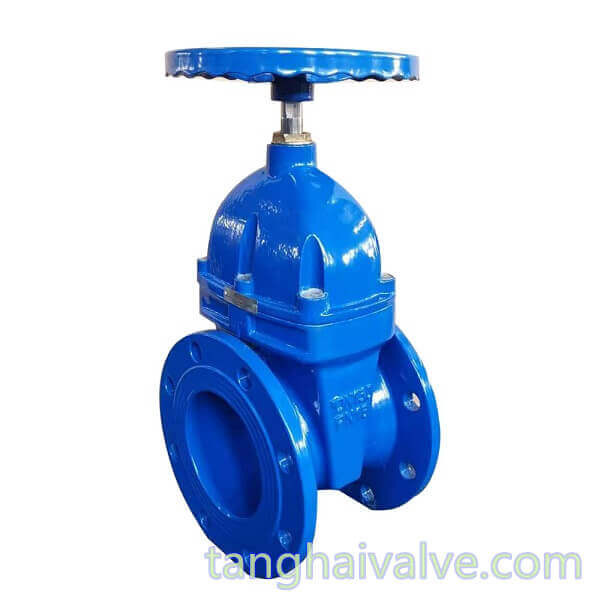The role and application of gate valve
This article introduces you to the function of gate valve, and then understands the purpose of gate valve. The gate valve is a very important control component on the pipeline that transports the fluid medium. The structure of the gate valve is composed of a valve body, a valve cover, a valve stem, a gate plate, a sealing ring, and a driving device. The driving device is usually a hand wheel, and it can also be equipped with a pneumatic or electric actuator.

DIN-F4-BB-NRS-soft seated-wedge gate valve-DN100-PN16-copper holding ring-handwheel (3)
The gate of the gate valve is a disc shape, and the valve stem is driven to realize the opening and closing of the valve. The movement direction of the valve stem and the gate is perpendicular to the valve body passage and the direction of fluid flow in the pipeline. The gate valve has only two states, fully open and fully closed, so it can only be used to cut off the flow of the medium in the pipeline, and cannot adjust the flow rate. In addition, when the gate valve is opened and closed, the stroke distance of the gate is long. Although the opening and closing is labor-saving, it takes time. Therefore, the function of the gate valve is very suitable for use in pipelines that do not need to be opened and closed frequently, and used as a cut off or connected to the circulating medium in the pipeline.
The gate of the gate valve has two sealing surfaces. When the gate valve is closed, the sealing surface of the gate can be pressed against the seat on one side by the pressure of the medium to achieve sealing, which is self-sealing. The gate is basically a forced sealing type, that is, when the gate valve is closed, it needs to rely on the external force of the medium to force the gate to the valve seat to ensure the sealing performance of the sealing surface of the gate valve.
Gate valves can be divided into open-stem gate valves and concealed-stem gate valves according to their structural form. The functions of the two structural forms of gate valves are not much different, and the more difference lies in the use environment.
1. The stem of the rising stem gate valve is exposed, and the opening and closing state of the valve can be observed intuitively when the valve is opened and closed, so as to avoid misoperation. But also because the valve stem is exposed, the height of the rising stem gate valve, which is originally large in height, is even greater. Therefore, the rising stem gate valve is suitable for use in places that require a lot of operating space, and is not suitable for working conditions with narrow space.
2. The valve stem of the concealed stem gate valve is inside the valve body, so the on-off state of the valve cannot be directly observed, and another indicating device is required. However, because the valve stem is in the valve body, the volume of the dark-stem gate valve is smaller than that of the open-stem gate valve, and it is more suitable for use in occasions where the operating space is small and the location is limited and the pipeline is dense.
When the gate valve is fully opened, there is no obstruction when the medium flows through the inside of the valve body passage, and the flow resistance is almost zero. In addition, the valve body channel of the gate valve is symmetrical on both sides, the medium can flow in both directions, and it is not affected by the flow direction of the medium during installation. The gate valve has a wide range of applications due to its good manufacturing process. Gate valves have a wide range of uses, and are widely used in water conservancy systems, water supply and drainage systems, as well as petroleum, chemical, electric power, urban construction, and fire protection industries.
TH Valve is a professional manufacturer of butterfly valve, gate valve, check valve, globe valve, knife gate valve, ball valve with API, JIS, DIN standard, used in Oil, Gas, Marine industry, Water supply and drainage, fire fighting, shipbuilding, water treatment and other systems, with Nominal Diameter of DN50 to DN1200, NBR/EPDM/VITON, Certificates & Approvals: DNV-GL, Lloyds, DNV, BV, API, ABS, CCS. Standards: EN 593, API609, API6D
Video of resilient seated gate valve:
Related news/knowledge:
Design Features of Electric Gate Valve
How many types of gate valves?
Difference between Soft seal gate valve and hard seal gate valve
Classification and advantages of gate valve



 © Copyright 2020 Tianjin Tanghaidongyang Valve Co., Ltd. All Rights Reserved.
© Copyright 2020 Tianjin Tanghaidongyang Valve Co., Ltd. All Rights Reserved.